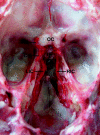Absence of carotid rete mirabile in small tropical ruminants: implications for the evolution of the arterial system in artiodactyls
- PMID: 17229288
- PMCID: PMC2100259
- DOI: 10.1111/j.1469-7580.2006.00667.x
Absence of carotid rete mirabile in small tropical ruminants: implications for the evolution of the arterial system in artiodactyls
Abstract
The intracranial carotid rete (or rete mirabile epidurale) is a unique blood vascular system supplying the brain of artiodactyls, which have either an involuted or no internal carotid artery. Although the lesser and greater mouse deer (Tragulus javanicus and T. napu, respectively) are ruminants, the rete mirabile epidurale is absent. In these animals, as in non-artiodactyls, such as canines, equines and humans, the complete internal carotid artery supplies the brain. It is currently uncertain whether the absence of the rete is confined to mouse deer among ruminants. The absence of the rete in mouse deer provides new insights into the evolution of the arterial system in artiodactyls.
Figures




References
-
- Baldwin BA. The anatomy of the arterial supply to the cranial regions of the sheep and ox. Am J Anat. 1964;115:110–117. - PubMed
-
- Bamel SS, Dhingra LD, Sharma DN. Anatomical studies on the arteries of the brain of buffalo (Bubalus bubalus). I. The rete mirabile cerebri. Anat Anz. 1975;137:440–446. - PubMed
-
- Daniel PM, Dawes JDK, Prichard MML. Studies of the carotid rete and its associated arteries. Phil Trans R Soc Lond Ser B. 1952;237:173–208.
-
- Edelman NH, Epstein P, Cherniak NS, Fishman AP. Control of cerebral blood flow in goat: role of the carotid rete. Am J Physiol. 1972;223:615–619. - PubMed
Publication types
MeSH terms
LinkOut - more resources
Full Text Sources

